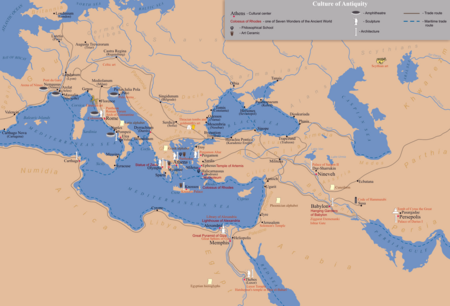Greco-Roman world
This article includes alist of references,related reading,orexternal links,but its sources remain unclear because it lacksinline citations.(November 2015) |


TheGreco-Roman civilization(/ˌɡriːkoʊˈroʊmən,ˌɡrɛkoʊ-/;alsoGreco-Roman cultureorGreco-Latin culture;spelledGraeco-RomaninBritish English), as understood by modern scholars and writers, includes the geographical regions and countries that culturally—and so historically—were directly and intimately influenced by the language, culture, government and religion of theGreeksandRomans.A better-known term isclassical antiquity.In exact terms the area refers to the"Mediterranean world",the extensive tracts of land centered on theMediterraneanandBlack Seabasins, the "swimming pool and spa" of the Greeks and the Romans, in which those peoples' cultural perceptions, ideas, and sensitivities became dominant inclassical antiquity.
That process was aided by the universal adoption ofGreekas the language of intellectual culture and commerce in theEastern Mediterraneanand ofLatinas the language ofpublic administrationand offorensic advocacy,especially in the Western Mediterranean.
Greek and Latin were never the native languages of many or most of the rural peasants, who formed the great majority of theRoman Empire's population. However, they became the languages of theurbanandcosmopolitanelitesand the Empire'slingua francafor those who lived within the large territories and populations outside theMacedonian settlementsand theRoman colonies.All Roman citizens of note and accomplishment, regardless of their ethnic extractions, spoke and wrote in Greek or Latin. Examples include the Roman jurist and imperial chancellorUlpianofPhoenicianorigin; the mathematician and geographerClaudius PtolemyofGreco-Egyptianethnicity; and the theologianAugustineofBerberorigin. Note too the historianJosephus Flavius,who was ofJewishorigin but spoke and wrote in Greek.[citation needed]
Cores
[edit]
Based on the above definition, the "cores" of the Greco-Roman world can be confidently stated to have been theItalian Peninsula,Greece,Cyprus,theIberian Peninsula,theAnatolian Peninsula(modern-dayTurkey),Gaul(modern-dayFrance), theSyrian region(modern-dayLevantine countries,Central and Northern Syria,LebanonandPalestine),EgyptandRoman Africa(corresponding to modern-dayTunisia,Eastern AlgeriaandWestern Libya). Occupying the periphery of that world were the so-called "Roman Germany" (the modern-dayAlpine countriesofAustriaandSwitzerlandand theAgri Decumates,southwesternGermany), theIllyricum(modern-dayNorthern Albania,Montenegro,Bosnia and Herzegovinaand the coast ofCroatia), theMacedonian region,Thrace(corresponding to modern-daySoutheastern Bulgaria,Northeastern Greeceand theEuropean portionofTurkey),Moesia(roughly corresponding to modern-dayCentral Serbia,Kosovo,Northern Macedonia,Northern BulgariaandRomanian Dobrudja), andPannonia(corresponding to modern-dayWestern Hungary,theAustrianLänderofBurgenland,Eastern SloveniaandNorthern Serbia).
Also included wereDacia(roughly modern-dayRomaniaandMoldavia),Mauretania(modern-dayMorocco,Western AlgeriaandNorthern Mauritania),Jordan,Southern Syriaand Egypt'sSinai Peninsula) and the Tauric Chersonesus (modern-dayCrimeaand the coast ofUkraine).
The Greco-Roman world had another "world" or empire to its east, the Persians, with which there was constant interaction:Xenophon,The Anabasis,the March Up Country, theGreco-Persian wars,the famous battles ofMarathonandSalamis,the Greek tragedyThe PersiansbyAeschylus,Alexander the Great'sdefeatof the Persian emperorDarius IIIand conquest of thePersian empire,or the later Roman generals' difficulties with the Persian armies, such asPompey the Great,and ofMarcus Licinius Crassus(conqueror of the slave generalSpartacus), who was defeated in the field by a Persian force and was beheaded by them.[1]
Culture
[edit]In the schools ofart,philosophy,andrhetoric,the foundations ofeducationwere transmitted throughout the lands of Greek and Roman rule. Within its educated class, spanning all of the "Greco-Roman" eras, the testimony of literary borrowings and influences are overwhelming proofs of a mantle of mutual knowledge. For example, several hundredpapyrusvolumes found in a Roman villa atHerculaneumare in Greek. The lives ofCiceroandJulius Caesarare examples of Romans who frequented schools in Greece.
The installation, both inGreekandLatin,ofAugustus's monumental eulogy, theRes Gestae,exemplifies the official recognition of the dual vehicles for the common culture. The familiarity of figures from Roman legend and history in theParallel LivesbyPlutarchis one example of the extent to which "universal history"was then synonymous with the accomplishments of famousLatinsandHellenes.Most educated Romans were likely bilingual in Greek and Latin.
Architecture
[edit]Graeco-Roman architecture in the Roman world followed the principles and style that had been established by ancient Greece. That era's most representative building was the temple. Other prominent structures that represented that style included government buildings like theRoman Senate.The three primary styles of column design used in temples in classical Greece wereDoric,Ionic,andCorinthian.Some examples of Doric architecture are theParthenonand theTemple of Hephaestusin Athens, and theErechtheum,next to the Parthenon, is Ionic.
Politics
[edit]This sectionmay beconfusing or unclearto readers.(December 2010) |
By AD 211, withCaracalla's edict known as theConstitutio Antoniniana,and although one of the edict's main purposes was to increase tax revenue, all of the empire's free men became citizens with all the rights this entailed. As a result, even after theFall of the Western Roman Empire,the people who remained within the lands (including Byzantium) that the empire comprised continued to call themselvesRhomaioi.(Helleneshad been referring to pagan, or non-Christian, Greeks until theFourth Crusade.) Through attrition of Byzantine territory in the preceding 400 or so years from perceived friends and foes alike (Crusaders, Ottoman Turks, and others), Constantinople, the capital of the Byzantine Empire (the Eastern Roman Empire) fell to the Turks led by Mehmed II in 1453. There is a perception that these events led to the predecessor ofGreek nationalismthrough theOttoman eraand even into modern times.
Religion
[edit]Greco-Roman mythology,sometimes calledclassical mythology,is the result of the syncretism between Roman and Greek myths, spanning the period of Great Greece at the end ofRoman paganism.Along withphilosophyandpolitical theory,mythology is one of the greatest contributions ofClassical antiquitytoWestern society.[2]
From a historical point of view,early Christianitywas born in the world of Greco-Roman influence which had a massive influence onChristian culture.[3]
See also
[edit]References
[edit]- ^Appian,The Civil Wars.
- ^Entry on "mythology" inThe Classical Tradition,edited byAnthony Grafton,Glenn W. Most,and Salvatore Settis (Harvard University Press, 2010), p. 614and passim.
- ^Marvin Perry, Myrna Chase, James Jacob, Margaret Jacob, Theodore H. Von Laue (1 January 2012).Western Civilization: Since 1400.Cengage Learning. p. XXIX.ISBN978-1-111-83169-1.
{{cite book}}:CS1 maint: multiple names: authors list (link)
Sources
[edit]- Sir William Smith (ed).Dictionary of Greek and Roman Geography.London: Spottiswoode and Co, 1873.
- Simon Hornblower and Antony Spawforth (ed).Oxford Classical Dictionary.Oxford University Press, 2003.
- William Emerton Heitland.Agricola: A Study of Agriculture and Rustic Life in the Greco-Roman World from the Point of View of Labour.Cambridge: University Press, 1921
